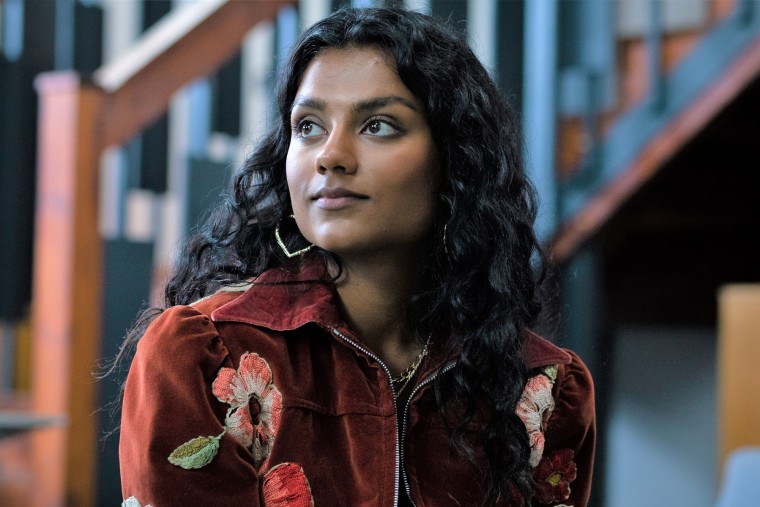When the British actress Simone Ashley was cast as the romantic lead in the upcoming second season of Netflix’s breakout hit drama “Bridgerton,” many fans of South Asian descent were thrilled — because it means that viewers of historical costume dramas will finally get the chance to see a South Asian woman in a leading romantic role.
“I feel like I’ve never seen a brown main character in a Western historical drama,” said Tashie Bhuiyan, 22, a young adult author.
She said she was inspired to read “The Viscount Who Loved Me,” the 2000 romance novel by Julia Quinn that the show's second season will be based on, after learning about Ashley’s casting. Bhuiyan’s debut novel “Counting Down with You,” about a Bangladeshi American teen who reluctantly agrees to date her school’s resident bad boy, will be released May 4. “We deserve to see fun romances that don't necessarily center on being brown. We deserve fun love stories.”
Best known for her role as Olivia Hanan on the Netflix series “Sex Education,” Ashley will portray Kate Sharma, a young woman who has recently arrived in London. She quickly draws the attention of Anthony Bridgerton, the scandalous viscount viewers first got to know during the show’s debut season. Originally named Kate Sheffield in Quinn's novel, the character was renamed Sharma for the television series.
But alongside the excitement around Ashley’s casting was also some criticism on social media about the accuracy of a woman of South Asian descent being accepted by the British aristocracy during the Regency era, which is when “Bridgerton” is set. The first season of “Bridgerton” featured several Black characters in its ensemble cast, including Regé-Jean Page as the main character Simon Basset and Golda Rosheuvel as Queen Charlotte.
“The short answer is yes, it’s historically accurate — especially during the era in which ‘Bridgerton’ is set,” historian Durba Ghosh, a professor at Cornell University, said. Ghosh said that during the Regency, which lasted from 1811 to 1820, many British officials from the East India Company had families with Indian women and often brought those children back to England during this period so they could be raised English. “Probably the most very well-known example of this was the daughter of James Achilles Kirkpatrick, Kitty Kirkpatrick,” she said. A colonel in the East India Company’s army, Kirkpatrick married an Indian woman, Khair un-Nissa. Kitty and her brother, William, were sent to England to be raised by their grandparents.
Before marrying, Kitty was considered the writer Thomas Carlyle’s muse, and references to the pair appeared in his essays and gossip items at the time. “There’s a reference to Carlyle having met them in London, so that’s obviously the kind of high society that ‘Bridgerton’ is set in,” Ghosh said.
What is less known is how much of their Indian cultural practices these children were permitted to retain once they arrived in England. Kitty Kirkpatrick and her brother, for example, were born with Muslim names but then were baptized, renamed and raised as Christians by their paternal family. But Ghosh said that many Anglo-Indian aristocrats did hold onto other aspects of their culture. “A lot of the clothes that they wore would have been very much influenced by Indian clothing,” she said. “They would have had things in their households like tea pots and brass pots that would be found in an elite Indian household.”
The way Kate will be styled by Bridgerton’s costume department is already a topic of discussion among viewers. “India has such amazing colors that I will be really eager to see if we see Indian textiles, and if we see our leading lady wearing saris,” said the author Sujata Massey, whose historical novel, “The Bombay Prince,” will be released in June. “Will she have a bindi? We know she should have fabulous jewelry.”
The inclusion of an Indian main character in “Bridgerton” also represents a major step in making historical dramas more diverse, but it’s not the first. In recent years, there have also been the Jamaica-set drama “The Long Song,” which aired on Masterpiece Theater, the BBC series “Sanditon,” the incomplete Jane Austen novel that features a biracial character, and the Oscar-nominated World War I drama “1917,” which includes the character of an Indian soldier.
“It is about time to show the world that Indians in particular are more than IT experts, doctors and all the stereotypical roles,” the Indian Malaysian comedian Prakash Daniel said. “As for the viewers, it also gives a diversified outlook to society especially in the context of a historical drama.”
Many are also eager to see a South Asian woman at the center of the whirling ballrooms that are at the heart of so many historical television shows. “It’s this whole idea of ‘we are wanted as we are,’” Bhuiyan said, adding that she wished that such representation existed when she was a teen. “To see a brown character idealized like that would be earth-shattering because it's like we've never had a chance to see ourselves like in that kind of spotlight.”
